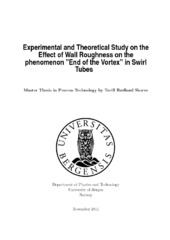Experimental and theoretical study on the effect of wall roughness on the phenomenon end of the vortex in swirl tubes
Master thesis
Permanent lenke
https://hdl.handle.net/1956/5762Utgivelsesdato
2011-11-18Metadata
Vis full innførselSamlinger
Sammendrag
In this thesis, a combination of experimental measurements and numerical simulations are used to investigate the phenomenon "End of the Vortex" in swirl tubes. The main focus here has been comparing swirl tubes containing walls with smooth surfaces to tubes with different heights of wall roughness. The tubes containing wall roughening were either treated with sandpaper or metal particles to achieve a uniform roughening at the wall throughout the whole section. The vortex has been visualized by two different methods; by inserting dust into the tube and by the use of high resolution pressure transducers on the separator tube. The experiments were carried out on different cylindrical tubes with lengths of 60, 80 and 100 cm. The effect of flow rate through the cyclone was studied. The results of the experimental measurements are compared with data from numerical simulations. 3-D RSM simulations were carried out using the commercial CFD package Star-CD. The obtained results showed qualitative agreement with each other. The results showed that the vortex core bent off to the wall further up in the separator tube when the walls contained a rough surface. The vortex also needed a higher flow rate before it went down to the bottom and centralized than it needed with a smooth surface.
